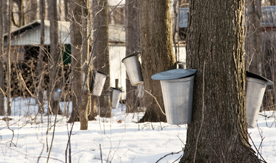Making Sense of Maple Syrup

Understanding more about the relationship between weather and maple sap flow, and how Maine syrup producers will adapt to climate change is the focus of research being conducted by a University of Maine graduate student.
Jenny Shrum, a Ph.D. candidate in the ecology and environmental sciences graduate program in the UMaine School of Biology and Ecology, is attempting to unravel the biophysical relationships between weather and sap flow. The goal is to better understand what drives flow and how expected trends in climate may affect the processes and harvesters in the future.
Shrum plans to collect on-site weather station data and sap flow rates at three test sites and to interview small- and large-scale producers to determine if those who have been managing sugar maple stands for years will be more or less resilient to climate change, and if large-scale producers will be better equipped to adapt. Her research is supported by the National Science Foundation and EPSCoR through UMaine’s Sustainability Solutions Initiative and its Effects of Climate Change on Organisms research project.
The physiological process for sap flow is not completely understood, Shrum says. It involves a complex interaction between freezing and thawing of the xylem tissue within the tree, and the molecule sucrose which maple trees use to store carbohydrates between seasons.
“When the tree defrosts, the frozen liquid in the tree becomes fluid and that provides a medium for the sugars that are stored in the trunk to get to the branches,” Shrum says, adding that in order to continue flowing, the ground also has to be defrosted so the tree can pull in water during the next freeze cycle and recharge the positive pressure in the trunk to restart sap flow.
Sugar maple trees grow as far north as New Brunswick and as far south as Georgia, yet maple syrup is only produced commercially in the 13 most northern states because of the colder weather, Shrum says.
In Maine and other northern areas, more than one freeze-thaw event happens during the winter. This lets the process repeat and allows the season to last between six and eight weeks as opposed to a few days, which is likely in southern states such as Georgia and Missouri, where maple trees grow but aren’t commercially tapped. Warm weather or microbial build-up in taps usually ends the season, according to Shrum.
In Maine, the season usually starts sometime between the middle of February and the middle of March, and continues for about six weeks, Shrum says.
“This winter has been really weird; we’ve had really warm weather and really cold weather and as far as sap flow, that might be a good thing,” Shrum says. “But not enough is known.”
One change that has been proven is the start time of the sap season.
“Studies are starting to show that the preferred block of time for tapping is starting earlier if you base it on ideal temperatures,” Shrum says, citing a 2010 Cornell University study by Chris Skinner that found that by 2100, the sap season could start a month earlier than it does now.
For big-time operations, Shrum says an earlier season probably won’t be a problem because they can just tap their lines earlier, but she’s not sure how smaller Maine operations will adapt.
“They might not be able to change their season,” she says. “A lot of the smaller operators have multiple jobs; they make money off maple syrup, but also in other fields such as woodcutting or construction. It just so happens maple syrup is a block of time when they’re not doing anything else, so it makes sense. But if that season changes, it might not fit into their schedule as well.”
Shrum will interview a variety of producers — small- and large-scale operators, people who have been tapping trees for 30 or more years and people who started within the past five years — to learn the reasons for tapping and better understand resilience within these groups.
To record weather and sap flow data, Shrum, who holds a bachelor’s degree in biology from Humboldt State University, will deploy weather stations at maple tree stands in Albion, Dixmont and Orono. She’s also using iButtons to record soil temperatures and time-lapse photography of the buckets to record hourly sap flow rates. She can then relate flow rates to variables the weather stations record, such as temperature, precipitation and sunlight.
Although climate change is likely to affect sap flow, Shrum is confident there will always be maple syrup made in Maine.
“None of the climate change scenarios that have come up result in maple trees not growing in Maine. We’re definitely still going to have freezing events in Maine; it’s not going to get so warm that that’s not going to happen,” she says.
Shrum says maple syrup could become a big commodity in Maine if more of a market was created through government incentive plans, and if the state decided to make it a priority — similar to Vermont.
“Everything is good about maple syrup. There’s very little that’s controversial about it, and the biology is fascinating,” Shrum says.
Contact: Elyse Kahl, 207.581.3747
